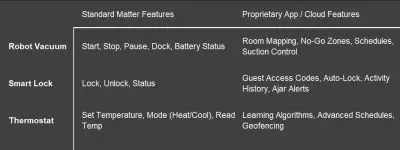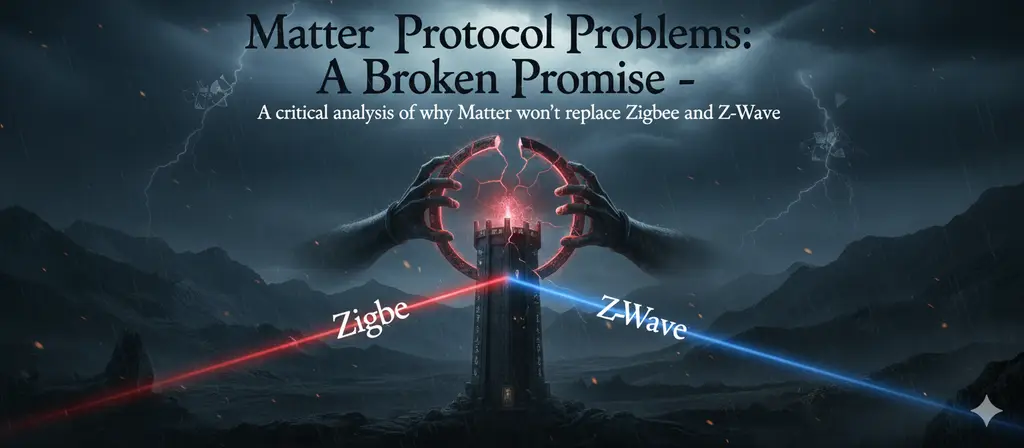A critical analysis of why Matter won’t replace Zigbee and Z-Wave
In the fragmented world of the smart home, Matter was forged to be the One Protocol to rule them all. It was meant to be a unifying force, an open standard that would bind the disparate devices from warring ecosystems (including: Apple, Amazon, and Google) into a single, harmonious fellowship.
The promise was legendary: a smart home that was not only interoperable but also reliable and locally controlled. The titans of tech heralded its creation as the ultimate solution to end the chaos. But like all great rings of power, its creation was tainted by the ambitions of those who forged it. The question now is whether this grand alliance was ever truly meant to succeed, or if Matter is destined for doom, a failed promise in a saga of corporate self-interest.
A few years into this grand experiment, Matter’s true nature has been revealed. A forensic look at Matter’s real-world implementation shows a standard that, while technically a step forward, has been systematically corrupted by the corporate self-interest of its creators. Instead of tearing down walled gardens, Matter has merely built a series of confusing and unreliable bridges between them.
The One Protocol offers power, but only a fraction of what was promised. It delivers about 70% of a solid smart home experience, but the critical 30% is strategically reserved for its true masters. These limitations are the source of the many issues plaguing early adopters. Matter isn’t a revolution; it’s a compromise designed to maintain the status quo. This directly answers the urgent question for many smart home owners: “Will Matter replace Zigbee?” The evidence suggests it won’t.
Broken Promises: The Core of Matter Protocol Problems
The core frustration with Matter is that it simply doesn’t work as advertised. The central pledge was interoperability, yet the ecosystem is defined by staggering inconsistency. The Connectivity Standards Alliance (CSA) maintains a consistent release schedule for the Matter specification, but the adoption of these new standards by the major platforms is woefully staggered and incomplete. This has created a crisis of smart home protocol fragmentation, leaving consumers with devices that may be certified for a feature their chosen smart home platform won’t support for months, or even years.
This isn’t a theoretical problem; it’s a real-world deception for users who bought into the promise. One homeowner vented online:
“I bought a new Matter-certified air purifier because the box had all the logos on it—Apple, Google, Amazon. I set it up in Google Home, and it worked fine. But when I tried to add it to Apple Home, it just wouldn’t show up. After hours of searching, I found out Apple hasn’t added support for air purifiers to their Matter implementation yet. What’s the point of the logo if it’s a lie?”
This chaos is not an accident; it is the direct result of a fundamental weakness: the “Optional Specification.” The CSA lacks the leverage to mandate that its powerful members fully adopt every part of the specification. This allows corporations to exercise a strategic veto, picking and choosing which device types to support. A consumer who buys a Matter-certified dishwasher will find it works on Amazon Alexa but may be completely invisible to Apple Home. This undermines the entire premise of the Matter logo and reveals that the standard was designed with built-in loopholes to perpetuate the very fragmentation it was supposed to solve.
The Administrative Nightmare: A Metadata Black Hole
Matter’s most celebrated feature, Multi-Admin, was meant to liberate users by allowing a single device to be controlled by multiple systems simultaneously. In practice, the feature is functionally broken, creating a user experience so frustrating it borders on unusable. It stands as one of Matter’s most visible shortcomings.
As one frustrated user on Reddit put it:
“Multi-admin is completely broken. I have tried to get multiple Matter devices set up in two, three, and sometimes four ecosystems at once… and it just does not work. If I manage to connect a device to more than one platform, invariably, it soon shows offline in one or the other platform and, in some cases, completely disappears from it altogether.”
Beyond the connection instability, the feature fails on a more fundamental level. When a device is shared with a secondary platform, no contextual information, or metadata, is transferred. The device name, the room it’s assigned to, and any associated automations are lost in a metadata black hole. The device appears in the new app as a nameless, generic entity like “On/Off Light” in a default room. For any home with more than a handful of devices, this makes multi-platform management practically untenable.
Matter 1.4 introduced “Fabric Sync” to supposedly fix this, allowing one ecosystem to automatically share its devices with another. However, this “fix” is useless for administrative management because the specification still does not mandate that device names and room locations be shared. This refusal to standardize something as simple as syncing a text string is not a technical oversight; it’s a strategic business decision. The tech giants view the user’s organizational schema of their own home as a proprietary, competitive asset, holding it hostage to strengthen user lock-in.
A House Built on Sand: The Hidden IPv6 Problem
Beyond the political failures lies a hidden technical flaw, a foundational issue that has caused immense frustration and is one of the hardest problems with the protocol to diagnose. The single most critical and overlooked detail of the standard is that it is built entirely and exclusively on Internet Protocol version 6 (IPv6). This is not optional; it’s a hard dependency.
This mandate has had disastrous consequences for real-world users, as many consumer-grade routers have poor or disabled-by-default IPv6 support. The internet is filled with tales from users battling unstable devices, only to discover the root cause lies in their network configuration. In one poignant example, a user detailed a grueling 1.5-year struggle with multiple brands of Matter devices, border routers, and network configurations. The problem, which had consumed countless hours and dollars, was ultimately traced back to:
“…a single IPv6 setting that I had set years ago and forgotten about.”
Matter’s rollout has inadvertently served as a massive, unplanned stress test of the global consumer networking industry. The protocol’s frequent failures are often misattributed to Matter itself when the true culprit is years of neglect of proper IPv6 implementation in routers. The CSA launched a protocol with a non-negotiable dependency that a significant portion of their target market’s infrastructure was not prepared for.
The Walled Gardens Remain Standing
A closer look at the Matter specification itself, reveals a pattern of strategic omissions designed to protect the most lucrative product categories for its corporate backers.

The most profound and telling exclusion is the entire category of security cameras, video doorbells, and alarm systems. The official reason cited is the technical complexity of standardizing real-time video streaming. This argument is unconvincing. Matter is an IP-based protocol that can run over high-bandwidth Wi-Fi and Ethernet, both more than capable of handling multiple HD video streams.
The true reason is economic protectionism. Standardizing secure, local video streaming would directly threaten the multi-billion-dollar recurring revenue streams from cloud subscriptions like Amazon’s Ring Protect and Google’s Nest Aware. By keeping camera control proprietary and cloud-dependent, the tech giants maintain absolute control over user data and the associated revenue. The exclusion of such a critical device category is one of Matter’s most glaring limitations.
This strategy of “managed mediocrity” extends even to supported device types. Robotic vacuums, for instance, were added in Matter 1.2. However, the specification only supports the most basic functions: start, stop, pause, and battery status. All of the advanced features that make a robot vacuum “smart,” (room mapping, no-go zones, targeted cleanings) remain locked away, accessible only through the manufacturer’s proprietary, cloud-connected app. This provides the perfect compromise for manufacturers: they get to place the Matter logo on the box but don’t have to give up the valuable user data and brand loyalty available through their own apps. This intentional crippling of functionality creates yet another set of frustrations for users who expect full control.
Will Matter Replace Zigbee or Z-Wave? Not While These Issues Remain
For readers wondering if Matter will supplant Zigbee or Z-Wave, the answer becomes clear when looking at the workhorses of the smart home. While Matter struggles, Zigbee and Z-Wave thrive. For those building a truly reliable and private “Sovereign Home” (a smart home that is locally controlled and independent of corporate cloud services), these mature protocols remain the superior choice for several key reasons:
- Proven Reliability and Maturity: Zigbee and Z-Wave have been around for over two decades. They are stable, well-understood protocols with a track record of dependable performance. Their mesh networking technology is robust and has been refined over years of real-world use. This long-term stability is a critical factor for anyone considering the future of these standards.
- Vast and Affordable Device Ecosystems: There are thousands of Zigbee and Z-Wave devices available from hundreds of manufacturers, covering nearly every conceivable need. This competition has driven prices down, making them far more cost-effective than the current premium-priced Matter devices.
- Independence from Corporate Politics: As established and open standards, Zigbee and Z-Wave are less susceptible to the political maneuvering that plagues Matter. Their development is driven by a broader consortium of companies focused on interoperability, not just a few tech giants protecting their core business models.
For anyone considering a switch to Matter, the conclusion is clear: for a smart home that is both intelligent and resilient, proven protocols provide the solid foundation that Matter, in its current state, simply cannot offer.
Resisting the Ring of Power
In the end, Matter reveals itself not as a unifying tool for all, but as a ring of limited power, forever bound to the will of its creators. Its enforcement of local IP control is a significant step forward, a welcome gleam of silver in its design. However, the protocol has been fundamentally corrupted by corporate optionality, which acts as the ring’s corrupting inscription, visible only when held to the fire of real-world use.
The dream of a single standard has been sacrificed at the altar of market share, creating a landscape of persistent shortcomings. The temptation is to wait for the ring to be perfected, but that day may never come. Matter will remain a lowest-common-denominator bridge, not a unified control plane.
The path to a truly Sovereign Home does not lie in wielding this flawed power. It lies with the free peoples of the smart home world: open-source platforms like Home Assistant and the proven, trusty protocols of Zigbee and Z-Wave. Like the swords of old, they are the reliable tools that have already earned our trust. A perfect smart home cannot be built on a single, flawed protocol. The answer to “will Matter replace Zigbee” is a firm no, at least for anyone seeking true reliability. The reader must resist the temptation of the One Protocol and instead build the core of their intelligent home on a fellowship of standards that truly serve them, not the lords of the walled gardens.

